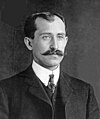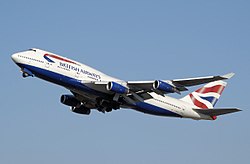Portal:Aviation
| Main page | Categories & Main topics |
|
Tasks and Projects |
The Aviation Portal

Aviation includes the activities surrounding mechanical flight and the aircraft industry. Aircraft includes fixed-wing and rotary-wing types, morphable wings, wing-less lifting bodies, as well as lighter-than-air craft such as hot air balloons and airships.
Aviation began in the 18th century with the development of the hot air balloon, an apparatus capable of atmospheric displacement through buoyancy. Some of the most significant advancements in aviation technology came with the controlled gliding flying of Otto Lilienthal in 1896; then a large step in significance came with the construction of the first powered airplane by the Wright brothers in the early 1900s. Since that time, aviation has been technologically revolutionized by the introduction of the jet which permitted a major form of transport throughout the world. (Full article...)
Selected article
Selected image
Did you know
...that the Soviet spotter aircraft Sukhoi Su-12, though approved, was never produced due to lack of manufacturing capacity in the USSR? ...that one of the first aircraft to cross the Atlantic was the Italian Savoia-Marchetti S.55 flying boat, which went on to serve in the Luftwaffe in WWII? ... that 820 Naval Air Squadron was involved in attacks on the German battleships Bismarck and Tirpitz during the Second World War?
General images -
In the news
- May 29: Austrian Airlines cancels Moscow-bound flight after Russia refuses a reroute outside Belarusian airspace
- August 8: Passenger flight crashes upon landing at Calicut airport in India
- June 4: Power firm helicopter strikes cables, crashes near Fairfield, California
- January 29: Former basketball player Kobe Bryant dies in helicopter crash, aged 41
- January 13: Iran admits downing Ukrainian jet, cites 'human error'
- January 10: Fire erupts in parking structure at Sola Airport, Norway
- October 27: US announces restrictions on flying to Cuba
- October 3: World War II era plane crashes in Connecticut, US, killing at least seven
- September 10: Nevada prop plane crash near Las Vegas leaves two dead, three injured
- August 6: French inventor Franky Zapata successfully crosses English Channel on jet-powered hoverboard
Related portals
Associated Wikimedia
The following Wikimedia Foundation sister projects provide more on this subject:
-
Commons
Free media repository -
Wikibooks
Free textbooks and manuals -
Wikidata
Free knowledge base -
Wikinews
Free-content news -
Wikiquote
Collection of quotations -
Wikisource
Free-content library -
Wikiversity
Free learning tools -
Wikivoyage
Free travel guide -
Wiktionary
Dictionary and thesaurus
Selected biography


The Wright brothers, Orville Wright (August 19, 1871 - January 30, 1948) and Wilbur Wright (April 16, 1867 - May 30, 1912), are generally credited with making the first controlled, powered, heavier-than-air flight on December 17, 1903. In the two years afterward, they developed their flying machine into the world's first practical airplane, along with many other aviation milestones.
In 1878 Wilbur and Orville were given a toy "helicopter" by their father. The device was made of paper, bamboo and cork with a rubber band to twirl its twin blades, and about a foot long. The boys played with it until it broke, then built their own. In later years, they pointed to their experience with the toy as the initial spark of their interest in flying.
Selected Aircraft

The Boeing 747 is a widebody commercial airliner, often referred to by the nickname Jumbo Jet. It is among the world's most recognizable aircraft, and was the first widebody ever produced. Manufactured by Boeing's Commercial Airplane unit in the United States, the original version of the 747 was two and a half times the size of the Boeing 707, one of the common large commercial aircraft of the 1960s. First flown commercially in 1970, the 747 held the passenger capacity record for 37 years.
The four-engine 747 uses a double deck configuration for part of its length. It is available in passenger, freighter and other versions. Boeing designed the 747's hump-like upper deck to serve as a first class lounge or (as is the general rule today) extra seating, and to allow the aircraft to be easily converted to a cargo carrier by removing seats and installing a front cargo door. Boeing did so because the company expected supersonic airliners (whose development was announced in the early 1960s) to render the 747 and other subsonic airliners obsolete; while believing that the demand for subsonic cargo aircraft would be robust into the future. The 747 in particular was expected to become obsolete after 400 were sold but it exceeded its critics' expectations with production passing the 1,000 mark in 1993. As of September 2023, 1,574 aircraft have been built, with the final delivery in January 2023.
The 747-8, the latest version in service, is among the fastest airliners in service with a high-subsonic cruise speed of Mach 0.855 (564 mph or 908 km/h). It has an intercontinental range of 7,730 nautical miles (14,320 km; 8,900 mi). The 747-8I (passenger version) can accommodate 467 passengers in a typical three-class layout. The 747-8 completed production on 6 December 2022 and the final 747 was delivered to Atlas Air on 31 January 2023.
Today in Aviation
- 2012 – Human Rights Watch accuses the Syrian government of using Russian-made cluster bombs in air attacks on populated areas and near key battlefields.[1]
- 2012 – General Chuck Yeager USAF (Ret.), age 89, breaks the sound barrier again in a commemorative flight over Edwards AFB, CA
- 2011 – Moremi Air Cessna 208 Crash occurred shortly after takeoff from Xakanaka Airstrip. The plane was heading to Pom Pom Airstrip, a notable place for tourists. Eight of the twelve passengers on board died.
- 2011 – The fourth prototype Xian JH-7A, 814, of the China Flight Test Establishment of the People's Liberation Army Air Force crashed into a marsh near Wei Nan City, Pucheng in Shaanxi Province, China, while performing in an airshow associated with the China International General Aviation Convention. Airframe came down ~1 mile (~1.6 km.) from Pucheng Neifu Airport. One pilot ejected safely but the second crewman is killed in the crash.
- 2005 – Air Jamaica Express ceased operations.
- 2004 – Pinnacle Airlines Flight 3701 (ICAO: FLG3701, IATA: 9E3701, or Flagship 3701) crashed near Jefferson City, Missouri, United States. It was an overnight ferry flight (with no passengers) from Little Rock, Arkansas, U. S. to Minneapolis-St. Paul International Airport, U. S. Both crew members were killed.
- 2004 – MK Airlines Flight 1602, a Boeing 747-200F, crashes on takeoff from Halifax Stanfield International Airport, killing all 7 on board.
- 1987 – An Lockheed F-117A Nighthawk, 83-815, of the 4450th Tactical Group, piloted by Maj. Michael C. Stewart, callsign BURNR ("burner") 54, crashes at 2033 hrs., ~100 miles N of Nellis AFB, just E of Tonopah. Stewart was just 40 minutes into a routine single-ship sortie when his plane crashed into the gently sloping terrain 60 miles E of Alamo, Nevada, pilot KWF.
- 1975 – A USAF McDonnell Douglas F-15A-7-MC Eagle, 73-0088, c/n 0027/A022, of the 555th TFTS, 58th TFTW, crashes W of Minersville, Utah, due to electrical smoke/fire from generator failure; pilot ejects safely. This was the first F-15 crash.
- 1975 – An RAF Avro Vulcan B.2, XM645, of 9 Sqn RAF Waddington breaks up over Żabbar, Malta, after a hard landing shears off the port-side undercarriage, piercing a wing fuel tank and starting a fire. The pilot and co-pilot initiate a second landing attempt but eject when they realize that the plane cannot make it back to the runway. The subsequent explosion kills 5 crew members who remained aboard, and an electrical cable severed by falling debris kills a bystander on the ground.
- 1968 – The first live telecast from any manned spacecraft, the Apollo 7, was launched by the NASA from Florida.
- 1965 – Joe Engle in an X-15 reaches an altitude of 80 km (49 miles).
- 1964 – First flight of the Sikorsky CH-53 Sea Stallion (YCH-53)
- 1964 – Boeing B-50D-80-BO Superfortress, 48-065, converted to KB-50J, of the 421st Air Refueling Squadron, Takhli RTAFB, crashed in Thailand this date shortly after takeoff on training mission while supporting Yankee missions over Laos. Corrosion found in wreckage led to early retirement of the KB-50 fleet and its replacement with Boeing KC-135s.
- 1962 – A US Air Force Lockheed U-2 reconnaissance flight over Cuba reveals the presence of launchpads for Medium Range Ballistic Missiles, triggering the Cuban Missile Crisis
- 1955 – A Strategic Air Command Boeing B-47E-90-BW Stratojet, 52-500, crashes while attempting landing on 3,400-foot (1,000 m) runway 27 at NAS Atlanta, Georgia, shearing off tail and coming to rest beside runway. This facility is now DeKalb-Peachtree Airport.
- 1953 – First flight of the North American X-10
- 1953 – Second of two Bell X-5 swing-wing testbeds, 50-1839, gets into irrecoverable spin condition at Edwards AFB, California during aggravated stall test, crashes in desert, killing test pilot Maj. Raymond Popson on his first flight in the type. On the same date, the nose gear of the XF-92 collapses, ending use by NACA.
- 1949 – First flight of the Fairchild C-123 Provider
- 1947 - Capt Chuck Yeager becomes the first person to fly faster than the speed of sound, past MACH 1 in the Bell X-1 named Glamorous Glennis at Muroc AFB, CA; now Edwards Air Force Base, CA. www.chuckyeager.com
- 1944 – 104 China-based B-29 s attack Formosa for the first time, striking an aircraft plant at Okayama. The combined bombload of 650 tons (589,676 kg) is the largest in history at the time.
- 1943 – U. S. 8th Air Force loses 60 B-17 Flying Fortresses during an assault on Schweinfurt.
- 1942 – The Japanese battleships Kongō and Haruna bombard Guadalcanal’s Henderson Field firing 973 14-inch (356-mm) shells in 1 h 23 min. The shelling kills 41 men and leaves only 42 aircraft operational out of 90 at the airfield.
- 1942 – P/O Beurling, flying a Supermarine Spitfire of No. 249 (RAF) Squadron, destroyed three enemy aircraft over Malta, but was shot down and wounded.
- 1941 – First accident involving Saro Lerwick flying boat assigned to No. 4 OTU occurs when L7268 dives into the sea near Tarbat Ness following failure of the port engine. Type could not maintain altitude on single powerplant. Six crew killed, three recovered alive.
- 1940 – Aircraft from the British aircraft carrier HMS Illustrious raid Leros.
- 1938 – First flight of the Curtiss P-40 Warhawk
- 1927 – 14-15 – Dieudonne Costes and Joseph le Brix make the first non-stop aerial crossing of the South Atlantic, flying a Breguet 19 from Saint-Louis, Senegal to Port Natal in Brazil, as a part of their round-the-world 57,000 km trip.
- 1922 – The Boeing-built MB-3 A (No. 54) flown by Lt. D. F. Stace wins the Pulitzer Trophy Race at Selfridge Field, Mich., flying 147.8 miles per hour over a 200-mile course.
- 1918 – Baron Willy Coppens, highest scoring Belgian ace, is heavily wounded, ending his combat career. He had scored 37 victories, 34 of which were observation balloons.
- 1910 – First confirmed flight over Norway by Carl Cederström.
- 1910 – English aviator Claude Grahame-White lands his Farman biplane on Executive Avenue (now Pennsylvania Avenue) near the White House.
- 1908 – Henry Farman makes the first cross-country flight in a power-driven aeroplane, from Bouy to Reims (27 km) in 20 min.
- 1905 – The Fédération Aéronautique Internationale (FAI) is founded in Paris
- 1897 – Clément Ader makes a 300 m flight in his steam-powered uncontrolled Avion III also referred to as Aquilon or the Éole III. The Army is not impressed and withdraws funding.
References
- ^ Assad forces using cluster bombs in Syria war: Human Rights Watch 14 October 2012.
- ^ "BBC News - Home". Bbc.com. 2012-10-14. Retrieved 2012-12-21.
- Shortcuts to this page: Portal:Airplanes • P:AVIA





















































